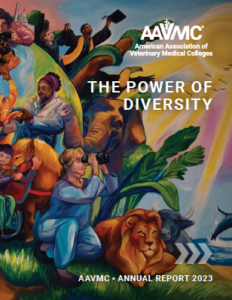Download a photo of keynote speaker Jeff Selingo.
Washington, D.C., March 18, 2020 – The AAVMC’s 2020 Annual Conference and Iverson Bell Symposium was held March 6-8 in Washington, D.C., just days before the COVID-19 virus almost instantly and quite profoundly changed everyday life in the United States.
The AAVMC implemented several biosecurity practices for the conference that seemed extremely cautious at the time but proved prudent in retrospect. Those included a “no handshake” policy and providing an abundance of hand sanitizer for the more than 300 attendees who gathered to enjoy an array of sessions, workshops, and networking opportunities.
On Thursday, March 5, 81 deans and other veterinary medical school representatives from 26 states conducted 156 meetings with Congressional members or staffers to discuss issues of importance to academic veterinary medicine.
COVID-19 awareness and concerns illuminated the importance of the profession and brought special urgency to conversations about targeted programs such as the 2019 Advancing Emergency Preparedness Through One Health Act, the America Grows Act (for agricultural research) and Section 1433, Formula Funds for Animal Health and Disease Research.
The conference kicked off on Friday, March 6 with programming that included dozens of expert presentations, workshops and keynote speakers such as Jeff Selingo, a writer for the Washington Post and the Chronicle of Higher Education, who is the author of two New York Times best sellers.
Selingo spoke on how technological and societal changes are prompting changes in education and what that might look like long-term. He stressed the need to develop platforms for lifelong learning and the development of student skills that can transfer from one domain to another, with structures that might rely more heavily on internships and flexible, digital learning. He also noted the need to develop outcomes-based, human skills “to complement rather than compete with technology.”
That human/technology interface theme resonated throughout the conference with sessions such as “Preparing Veterinary Graduates for a Changing Profession: Using Hackathons as a Vehicle to Teach Vital Professional Skills” and a “Use of Animals in Education Symposium.”
The symposium examined both the benefits and limitations of using simulations, haptic training models, cadavers, or critically ill animals to teach veterinary medical skills, and how to objectively evaluate the effectiveness of different approaches.
Dr. Philp Nelson, dean of the College of Veterinary Medicine at the Western School of Health Sciences, spoke about his school’s policy that no animals will be harmed or die as part of their educational programs. The school relies heavily on willed bodies, conducts memorial services for the donated animals and invites donors to write personal stories about their relationships with the donated animals and the impact on their lives.
AAVMC President-elect Paul Lunn, dean of the college of veterinary medicine at North Carolina State University, talked about the need to constantly study and evaluate the use of animals to ensure that they are only used ethically and with careful, balanced consideration to all factors. “I think we’re at a time where we have an opportunity to exercise careful scrutiny and evaluate whether we’re really following best practice,” he said—something the AAVMC intends to encourage members to do.
New this year, award winners were introduced via compelling, professionally produced videos that profiled honorees. One award-winner, Iverson Bell awardee Dr. Sandra San Miguel, took the stage in a flowing cape to illustrate how she inspires young students to become superheroes through learning about science and veterinary medicine.
Videos also profiled Iverson Bell awardee Jaime Gongora, Distinguished Veterinary Teacher Award recipient Dr. Jerome Masty, Excellence in Research Award recipient Dr. Peter J. Havel, Billy E. Hooper Award for Distinguished Service Award recipient Dr. Eleanor Green, and Senator John Melcher Leadership in Public Policy Award recipient Dr. Glen Hoffsis. The Presidential Award for Meritorious Service was awarded to members of the Competency-based Veterinary Education (CBVE) group and to Dr. Darcy Hall and Dr. Karen Cornell for their work with the AAVMC’s Leadership Academy.
In another new development, programming normally featured during the Iverson Bell Symposium, previously a biennial event, was factored into presentations throughout the meeting. The decision to make the Iverson Bell Symposium a part of every conference was made to reinforce the idea that diversity and inclusion should infuse everything that AAVMC members do.
Some of those sessions included “When Hate is a Crime: Creating an Inclusive and Safe Environment on Campus,” “Policies, Practices and Practices and Places: Supporting Religious, Secular and Spiritual Identities in Veterinary Medical Education,” and “Where are the Men?”
In “Where are the Men,” the AAVMC’s Senior Director for Institutional Research and Diversity Dr. Lisa Greenhill outlined some of the factors that discourage men from entering veterinary medicine. She stressed that we need to work harder to develop the pipeline for males with concerted efforts such as mentoring, developing role models, and focusing on salaries. She acknowledged the efforts will likely take years before gleaning results.
Keynote speaker Dr. Ashanti Johnson used her personal story, experience and empirical evidence to emphasize the benefits of diversity and inclusion in a talk on “Diversity, Equity and Belonging.” Dr. Johnson is one of the first African American female chemical oceanographers in the U.S. and a leading expert on diversity in STEM. She spoke about the importance of prioritizing and cultivating input from diverse viewpoints and how organizations can encourage diversity in everything from interpersonal dynamics to programmatic initiatives, mentorship and career development.
“Share your story,” she said, because once you’ve done it, you become the best practice.”
View a comprehensive online conference summary here.
About the AAVMC
The member institutions of the American Association of Veterinary Medical Colleges (AAVMC) promote and protect the health and wellbeing of people, animals and the environment by advancing the profession of veterinary medicine and preparing new generations of veterinarians to meet the evolving needs of a changing world. Founded in 1966, the AAVMC represents more than 40,000 faculty, staff and students across the global academic veterinary medical community. Our member institutions include 53 Council on Education (COE) accredited veterinary medical colleges and schools in the United States, Canada, Mexico, the Caribbean, the United Kingdom, Europe, Asia, Australia, and New Zealand; 23 provisional and collaborating members; and departments of veterinary science and departments of comparative medicine in the U.S.
– 30 –





SHARE